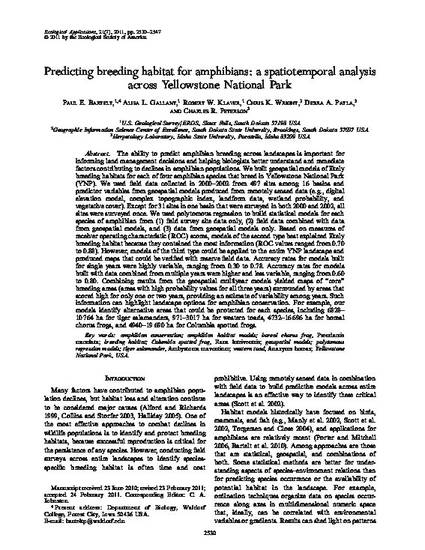
Article
Predicting breeding habitat for amphibians: a spatiotemporal analysis across Yellowstone National Park
Ecological Applications
(2011)
Abstract
The ability to predict amphibian breeding across landscapes is important for
informing land management decisions and helping biologists better understand and remediate
factors contributing to declines in amphibian populations. We built geospatial models of likely
breeding habitats for each of four amphibian species that breed in Yellowstone National Park
(YNP). We used field data collected in 2000–2002 from 497 sites among 16 basins and
predictor variables from geospatial models produced from remotely sensed data (e.g., digital
elevation model, complex topographic index, landform data, wetland probability, and
vegetative cover). Except for 31 sites in one basin that were surveyed in both 2000 and 2002, all
sites were surveyed once. We used polytomous regression to build statistical models for each
species of amphibian from (1) field survey site data only, (2) field data combined with data
from geospatial models, and (3) data from geospatial models only. Based on measures of
receiver operating characteristic (ROC) scores, models of the second type best explained likely
breeding habitat because they contained the most information (ROC values ranged from 0.70
to 0.88). However, models of the third type could be applied to the entire YNP landscape and
produced maps that could be verified with reserve field data. Accuracy rates for models built
for single years were highly variable, ranging from 0.30 to 0.78. Accuracy rates for models
built with data combined from multiple years were higher and less variable, ranging from 0.60
to 0.80. Combining results from the geospatial multiyear models yielded maps of ‘‘core’’
breeding areas (areas with high probability values for all three years) surrounded by areas that
scored high for only one or two years, providing an estimate of variability among years. Such
information can highlight landscape options for amphibian conservation. For example, our
models identify alternative areas that could be protected for each species, including 6828–
10 764 ha for tiger salamanders, 971–3017 ha for western toads, 4732–16 696 ha for boreal
chorus frogs, and 4940–19 690 ha for Columbia spotted frogs.
Keywords
- amphibian conservation,
- amphibian habitat models boreal chorus frog Pseudacris maculata,
- breeding habitat,
- Columbia spotted frog Rana luteiventris,
- geospatial models,
- polytomous regression models,
- tiger salamander Ambystoma mavortium,
- western toad Anaxyrus boreas,
- Yellowstone National Park USA
Disciplines
Publication Date
October, 2011
DOI
10.1890/10-1261.1
Publisher Statement
Works produced by employees of the U.S. Government as part of their official duties are not copyrighted within the U.S. The content of this document is not copyrighted.
Citation Information
Paul E. Bartelt, Alisa L. Gallant, Robert W. Klaver, Chris K. Wright, et al.. "Predicting breeding habitat for amphibians: a spatiotemporal analysis across Yellowstone National Park" Ecological Applications Vol. 21 Iss. 7 (2011) p. 2530 - 2547 Available at: http://works.bepress.com/robert-klaver/33/
